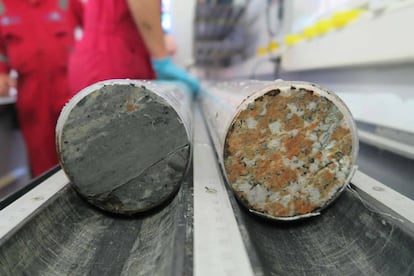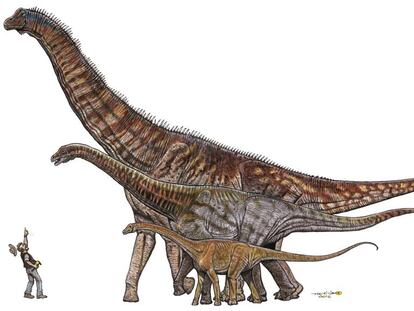Scientists reconstruct the day after the asteroid impact that led to the dinosaurs’ extinction
A study from 2019 provides minute-by-minute information about the events of 66 million years ago thanks to a cylinder of sediment extracted from deep within the Earth

Around 66 million years ago, give or take a thousand years, an asteroid hit Earth in what is today the Gulf of Mexico. The impact was so great that most scientists believe that it caused the disappearance of 75% of life, beginning with the dinosaurs. A study of a cylindrical cross-section of rock extracted from the impact site has allowed scientists to reconstruct minute by minute what happened on the first day after the collision. And, according to the research, published in 2019 in the science journal Proceedings of the National Academy of Sciences (PNAS), it was a veritable inferno.
In 2016, scientists on Expedition 364 traveled to the Chicxulub impact crater, located northeast of the Yutucán peninsula in Mexico, to extract a cylinder of rock from the site. They did not drill into the middle of the crater, but rather from its outside border, known as the peak ring. From there, they extracted a drill core from up to 1,334 meters below sea level. The cross-section of core’s rock layers, which have since been studied by a wide group of geologists and scientists from other fields, tells the story of what happened after the impact with the same precision as tree rings or ice cores, even though millions of years have passed.
“It is one of the advantages of impact craters. Their formation follows very well-defined laws of physics,” explains Jen Olof Ormö, an investigator from the Astrobiology Center at Spain’s national research institute CSIC and a coauthor of the study. “We can reconstruct a sequence of events, for example, see what sediments follow one another. Based on the type of sediment, the size of the debris, its type and classification, we can know if it was deposited quickly or slowly, and in approximately how much time.”

The asteroid hit Chicxulub with the equivalent power of 10 billion atomic bombs of the size used in World War II. It volatilized enormous amounts of material, and earlier studies estimate that it released 424 gigatons of carbon dioxide and another 325 of sulfur into the atmosphere – one gigaton is the equivalent to one billion metric tons. It triggered a tsunami that brought water from the Caribbean Sea to the great lakes in the north of the United States, some 2,500 kilometers away from the impact site.
But what is of most interest to geologists is how quickly most of the crater was filled with debris from the violent collision. It is estimated that the crater was covered with a layer of sediment 130 meters deep within just 24 hours. This sediment, which is being studied now, tells the story of the first day on Earth after the impact. This is the moment that, according to geologists, marks the end of the Mesozoic Era and the beginning of the current geological era, the Cenozoic. And it is at this point when nearly everything indicates that dinosaurs began to disappear and mammals began to rise to dominance.
According to the study, the first 40-50 meters of the crater, made up of melted rock and breccia (fragments less than two millimeters), were deposited within minutes of the impact. One hour later, a new, 10-meter thick layer was formed, made up of suevite, molten glass and other melted materials. Hours later an 80-meter thick layer of finer backflow reached the crater, bringing with it enormous amounts of material from the region and from areas much further away.
In the final layers, researchers found large amounts of organic material, especially traces of fungus and charcoal. This is due to the arrival of debris from fires caused by the impact of the asteroid, as well as burning material that rained down on the Earth. This material came from forests that spanned hundreds of kilometers.
We are before empirical evidence of the connection between the impact of the asteroid and the great extinctionJaime Urrutia, researcher from the Autonomous University of Mexico
“With a 12-kilometer long asteroid hitting Yucatán, the local effects must have been catastrophic and they probably were too at distances of up to 1,500 kilometers from the impact, where the thermal pulse could have been able to burn trees,” Sean Gulick, the main coauthor of the study and a professor of the Geophysics Institute at the University of Texas, tells EL PAÍS by email. “At greater distances, the material ejected would have also caused fires due to friction as it fell from the atmosphere. But these effects would have been short-lived and do not explain the global extinction of 75% of life.”
Although the extinction began that day, it must have lasted for years. In the drill core extracted from the Chicxulub crater, there is a striking absence of sulfuric material, even though there are lots of sulfur-rich rocks in the surrounding area. This supports the theory that the asteroid expelled enormous amounts of sulfur into the atmosphere, which blocked solar radiation and cooled the planet. Simulations indicate that the average global temperature fell 20ºC and stayed that way for 30 years.
“We are before empirical evidence of the connection between the impact of the asteroid and the great extinction,” says Jaime Urrutia, a researcher from the Autonomous University of Mexico (UNAM) and one of the leaders of the group investigation, and who has been studying the Chicxulub crater for several decades. For him, the contribution of the work is the timeline it offers on the sequence of events that happened 66 million years ago and marked the future of the planet.
English version by Melissa Kitson.
Tu suscripción se está usando en otro dispositivo
¿Quieres añadir otro usuario a tu suscripción?
Si continúas leyendo en este dispositivo, no se podrá leer en el otro.
FlechaTu suscripción se está usando en otro dispositivo y solo puedes acceder a EL PAÍS desde un dispositivo a la vez.
Si quieres compartir tu cuenta, cambia tu suscripción a la modalidad Premium, así podrás añadir otro usuario. Cada uno accederá con su propia cuenta de email, lo que os permitirá personalizar vuestra experiencia en EL PAÍS.
¿Tienes una suscripción de empresa? Accede aquí para contratar más cuentas.
En el caso de no saber quién está usando tu cuenta, te recomendamos cambiar tu contraseña aquí.
Si decides continuar compartiendo tu cuenta, este mensaje se mostrará en tu dispositivo y en el de la otra persona que está usando tu cuenta de forma indefinida, afectando a tu experiencia de lectura. Puedes consultar aquí los términos y condiciones de la suscripción digital.
More information
Archived In
Últimas noticias
Most viewed
- Christian Louboutin: ‘Young people don’t want to be like their parents. And if their parents wear sneakers, they’re going to look for something else’
- ‘El Limones’ and the growing union disguise of Mexican organized crime
- Cartels in Mexico take a leap forward with narco-drones: ‘It is criminal groups that are leading the innovation race’
- The low-cost creative revolution: How technology is making art accessible to everyone
- ‘We are dying’: Cuba sinks into a health crisis amid medicine shortages and misdiagnosis











































